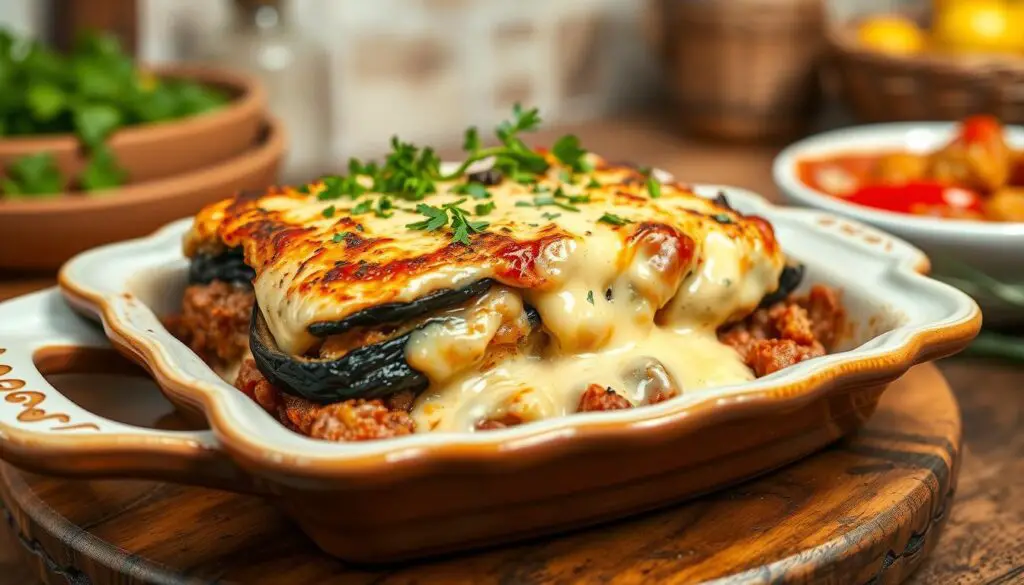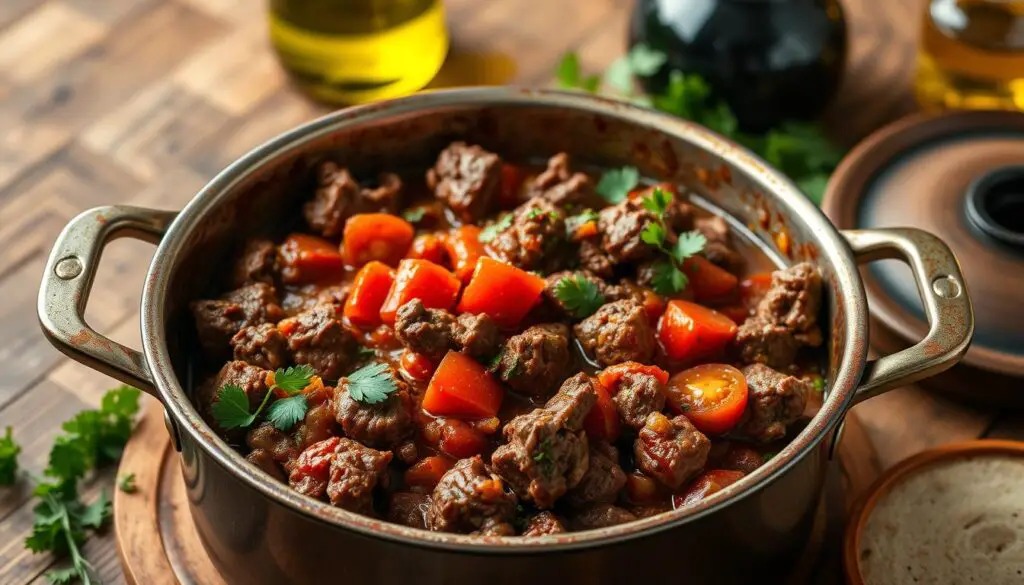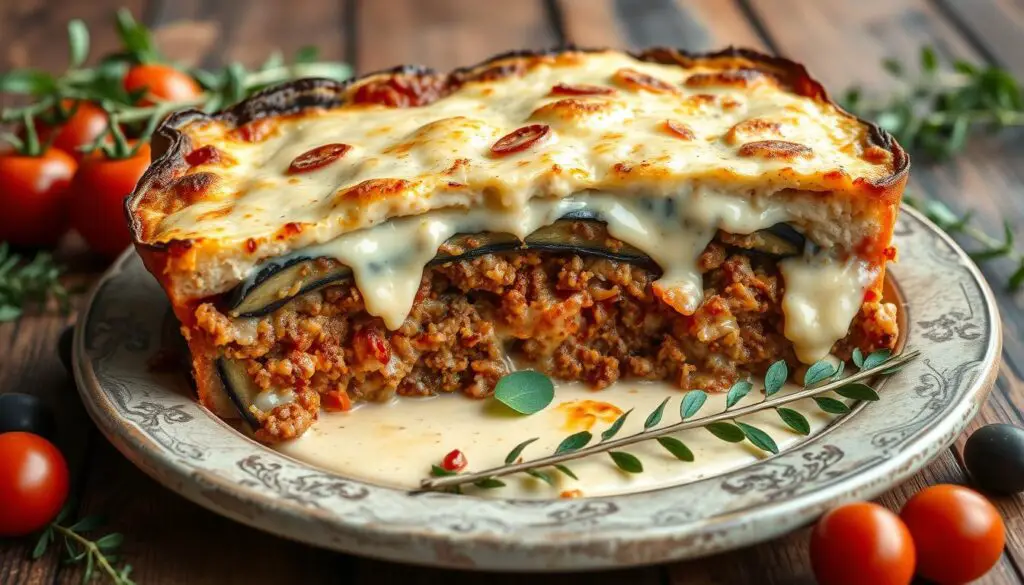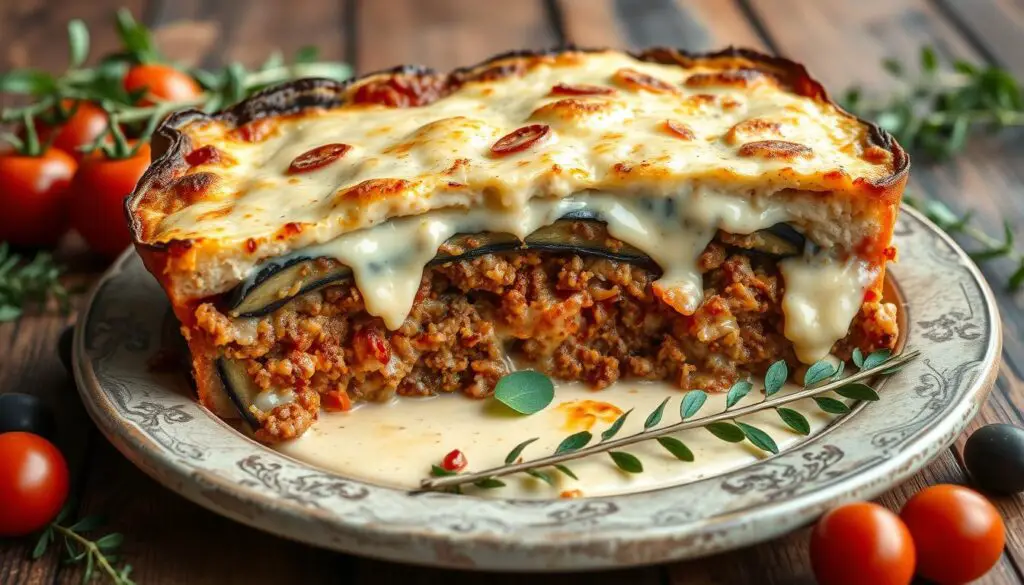Greek moussaka is a dish loved by many around the world. It’s a mix of Mediterranean flavors, rooted in the region’s rich food traditions. The dish combines fragrant eggplant, savory ground meat, and creamy béchamel sauce. Together, they create a delicious and satisfying meal.
The modern version of moussaka was made famous by chef Nikos Tselementes in the 1920s. It’s now a favorite in homes across Greece and beyond. Making this dish takes time and effort, but it’s worth it. It brings the flavors of Greece right to your table.

Key Takeaways
- Greek moussaka is a layered casserole dish with roots in Mediterranean and Middle Eastern cuisine.
- The modern Greek version was popularized by chef Nikos Tselementes in the 1920s.
- Moussaka is a hearty, comforting dish that combines eggplant, ground meat, and a creamy béchamel sauce.
- Preparing moussaka requires time and patience, but the end result is a rich, flavorful masterpiece.
- Moussaka is a beloved staple in Greek households and has gained popularity worldwide.
Understanding the Rich History of Moussaka
Moussaka is a beloved dish from the Mediterranean. It has roots that go back centuries and across cultures. This casserole, with its layers of eggplant, meat sauce, and creamy béchamel, shows the culinary exchanges in the region.
Origins in Mediterranean Cuisine
The history of moussaka starts in the Byzantine era. Eggplant and ground meat were common then. As time went on, the dish changed as it spread through cultural influences.
Evolution Through Different Cultures
Moussaka has traveled from the Middle East to the Balkans. In Turkey, zucchini is added, while in the Balkans, potatoes are used. These changes show how the dish has grown and stayed popular.
The Modern Greek Interpretation
The modern Greek version of moussaka is well-known. It combines eggplant, minced meat, and béchamel sauce. This version highlights the Mediterranean’s culinary richness and Greek chefs’ skill in blending influences.
“Moussaka is a harmonious blend of flavors and textures, reflecting the essence of Greek culinary traditions and the cultural influences that have shaped it over the centuries.”
Essential Ingredients for Perfect Greek Moussaka
Greek moussaka is a beloved dish in Mediterranean cuisine. It’s a layered casserole with a mix of flavors and textures. The key ingredients are eggplant, ground meat, and béchamel sauce. Each one is important for the dish’s taste.
Eggplant is the base of the dish, providing a rich and tender texture. Potatoes add heartiness and a subtle flavor. The meat sauce, made with ground beef or lamb, has Greek spices like cinnamon and nutmeg. These spices give it a warm and aromatic taste.
The béchamel sauce is the dish’s crowning glory. It’s a smooth white sauce made with butter, flour, milk, and béchamel sauce. This creamy layer holds the dish together and adds a velvety texture.
To make perfect Greek moussaka, choosing and preparing ingredients is key. You need to salt and roast the eggplant, make a robust meat sauce, and a flawless béchamel. Each step is crucial for a delicious dish.
Whether you’re a Greek cuisine expert or new to moussaka, learning about these essential ingredients is vital. It helps you make the most of this beloved Mediterranean dish.
“Moussaka is a dish that truly captures the essence of Greek culinary tradition, where the interplay of flavors and textures creates a harmonious and comforting experience.”
Preparing the Eggplant Layer
Making the perfect Greek moussaka begins with the eggplant layer. This layer is key, as it affects the dish’s taste and texture. Let’s look at how to prepare the eggplant layer right.
Proper Salting Technique
Salting the eggplant is a must to remove excess moisture and bitterness. Start by cutting the eggplants into 3/8-inch rounds. Place the slices on a baking sheet or large platter, then sprinkle them with salt.
Let the eggplant sit for 45 minutes. The salt will pull out water and bitter compounds.
Roasting Methods
After salting, it’s time to roast the eggplant. Heat your oven to 400°F (200°C). Pat the eggplant slices dry with paper towels.
Put the eggplant slices on a baking sheet lined with parchment paper. Drizzle with a bit of olive oil. Roast for 6-12 minutes, flipping halfway, until they’re golden and tender.
Achieving the Perfect Texture
The eggplant layer should be tender yet firm. By salting and roasting, you get the perfect texture. This texture complements the other layers, making the moussaka delicious.
Crafting the Signature Meat Sauce
The heart of a delicious Greek moussaka is the ground beef or lamb meat sauce. This tomato-based sauce ties together the eggplant and béchamel layers. It creates a perfect mix of textures and tastes.
To make the meat sauce, start by cooking onions and garlic in a skillet until they’re soft and smell good. Then, add the ground beef or lamb, breaking it up as it cooks. Brown the meat, then add tomato paste for a deep tomato flavor.
Next, add red wine to the pan to get all the tasty bits from the bottom. Season with spices like cinnamon, nutmeg, and allspice to get that Greek flavor.
Let the sauce simmer for 30-45 minutes. This lets the flavors mix well and the sauce thicken. Some recipes add breadcrumbs or feta cheese for extra texture.
Now that the meat sauce is ready, you can start building your Greek meat sauce masterpiece. The secret to a great moussaka is balancing each layer perfectly. The meat sauce is key to this balance.

“The secret to a truly authentic Greek moussaka is in the perfect balance of the meat sauce, eggplant, and béchamel layers.”
| Ingredient | Quantity |
|---|---|
| Ground beef or lamb | 1 lb (450g) |
| Onion, diced | 1 medium |
| Garlic, minced | 3 cloves |
| Tomato paste | 2 tablespoons |
| Red wine | 1/2 cup (120ml) |
| Cinnamon | 1 teaspoon |
| Nutmeg | 1/2 teaspoon |
| Allspice | 1/4 teaspoon |
| Salt and pepper | To taste |
Mastering the Béchamel Sauce
The creamy béchamel sauce is the heart of Greek moussaka. It makes the dish rich and creamy. To make the perfect béchamel, follow a few key steps.
Creating the Perfect Roux
Melt butter in a saucepan over medium heat. Then, whisk in an equal amount of flour to make a smooth roux. Cook it for 2-3 minutes, stirring constantly, to remove the raw flour taste.
Adding Traditional Seasonings
Pour in the milk slowly, whisking all the time to avoid lumps. Simmer it gently and add a pinch of nutmeg for a warm flavor. You can also add grated Parmesan cheese for extra taste.
Achieving Silky Smoothness
To get a velvety béchamel, cook it until it thickens. This takes 10-15 minutes of simmering. If it’s too thin, add a cornstarch mixture to thicken it.
With a perfect béchamel sauce, your Greek moussaka will be a hit. It will be full of flavor and creaminess.
Layer Assembly Techniques
Making the perfect Greek moussaka is all about layering. It’s a mix of eggplant, potatoes, and meat sauce, topped with creamy béchamel. This classic dish is a symphony of flavors and textures.
Start with a layer of sliced potatoes at the bottom. This base is strong and supports the moussaka. Then, add layers of roasted eggplant, slightly overlapping them.
- Spread the meat sauce over the eggplant, covering it all.
- Add another layer of eggplant, making it even more delicious.
- Top it off with creamy béchamel sauce, filling every corner.
For a Greek twist, some add zucchini or cheese between layers. These extras bring more flavor and beauty to your layering casserole.
| Ingredient | Quantity |
|---|---|
| Potatoes | 3 medium |
| Eggplant | 3 medium |
| Olive oil | 5 tablespoons |
| Ground beef or lamb | 1 kg (2 lbs) |
| Béchamel sauce | 600ml (2 1/2 cups) |
The secret to great moussaka assembly is in the layering. This careful process balances flavors and textures. It makes every bite of this Greek casserole a joy. It’s perfect for any gathering, from a ghoulish party to a family dinner.

The Art of Greek Moussaka
Baking the perfect Greek moussaka is a delicate art. It needs careful temperature control and precise timing. This beloved dish is a true masterpiece of Mediterranean cuisine. It showcases the rich flavors and textures of eggplant, meat, and béchamel sauce.
Traditional Layering Method
The traditional way to make moussaka is by layering. First, the roasted eggplant slices are at the bottom. Then, the savory ground meat sauce goes on top. Finally, the creamy béchamel sauce is poured over and baked until golden-brown and bubbly.
Temperature Control Tips
Getting the right texture and doneness in moussaka is all about temperature. It’s baked at 350°F (175°C) for 45-60 minutes. When it’s golden-brown on top and bubbly around the edges, it’s ready.
Timing and Doneness Indicators
- Roast the eggplant and potatoes for 35-40 minutes until lightly golden.
- Sauté the onions and garlic for 10 minutes to develop their flavors.
- Simmer the meat sauce for 30 minutes, allowing the flavors to meld.
- Bake the assembled moussaka for 45-60 minutes, until the béchamel sauce is set and the top is golden-brown.
- Let the moussaka rest for at least 30 minutes before serving to ensure clean, neat slices.
By focusing on temperature and timing, you can make sure your Greek moussaka is perfect. Each layer will be seamlessly integrated and full of authentic Mediterranean flavors. It’s perfect for a cozy family dinner or a festive gothic halloween gathering.
Serving and Presentation Guidelines
When serving Greek moussaka, paying attention to detail is crucial. It’s best served warm, not scorching hot. This lets the flavors blend and the layers settle. Traditionally, it’s cut into squares or rectangles, topped with fresh parsley for a pop of color.
Side dishes add to the Greek food presentation. A fresh Greek salad, creamy tzatziki sauce, or warm pita bread are great choices. Serving moussaka in ramekins or small baking dishes adds a Mediterranean touch.
The moussaka’s layered texture and golden top make it a feast for the eyes. It’s a stunning presentation that will wow your guests. By focusing on authentic Greek flavors and Mediterranean flair, you’ll make your moussaka experience unforgettable.
